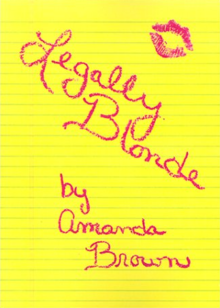 First edition cover First edition cover | |
| Author | Amanda Brown |
|---|---|
| Language | English |
| Genre | Comedy |
| Publisher | AuthorHouse |
| Publication date | 2001 (self-published), 2003 (official publication) |
| Publication place | United States |
| Pages | 185 |
| ISBN | 978-0-75964-018-4 |
| OCLC | 47926797 |
Legally Blonde is a 2001 comic novel by American author Amanda Brown, with a copyright credit also going to Brigid (Bridget) Kerrigan.
The novel was the basis of the 2001 film Legally Blonde which starred Reese Witherspoon and its 2003 sequel Legally Blonde 2: Red, White & Blonde, as well as the 2007 musical Legally Blonde and the 2009 direct-to-video film Legally Blondes.
The novel was based on Brown's experiences while enrolled in Stanford Law School.
Legally Blonde is also the first in a series young adult novels featuring the character of Elle Woods written by Natalie Standiford.
Plot
Elle Woods, a blonde University of Southern California sorority president and homecoming queen, is deeply in love with her college sweetheart, Warner Huntington III. When Warner enrolls in Stanford Law School and aims to find a girl more serious than Elle to be his bride, Elle schemes a plan to follow him there to win him back.
References
- ^ Silverman, Amy (October 30, 2003). "Legally Brown". Phoenix New Times.
- ^ Scott, A. O. (July 13, 2001). "Legally Blonde (2001) FILM REVIEW; A Rich Ditz Has Both Brains and the Last Laugh". The New York Times.
- Lozada, Carlos (June 23, 2015). "When the Confederate flag flew at Harvard". The Washington Post.
- "Campus Life: Harvard; Confederate Flags Prompt Protests And Debates". The New York Times. March 24, 1991.
- "Juvenile Series and Sequels Title: Elle Woods". Mid-Continent Public Library. Archived from the original on September 8, 2015.
- "Legally Elle Woods". FictFact. Archived from the original on April 15, 2016.
| Legally Blonde by Amanda Brown | |
|---|---|
| Books | |
| Films | |
| Music | |
| Characters | |
| Other works | |
This article about a comedy novel of the 2000s is a stub. You can help Misplaced Pages by expanding it. See guidelines for writing about novels. Further suggestions might be found on the article's talk page. |